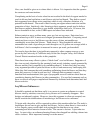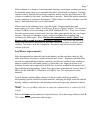
Page 11
Guideline # 5
Minimize dust during normal cleanup operations.
There is a logical, yet incorrect conclusion that leaf
blowers generate vast amounts of dust. Of course, they
can, but when used properly, they contribute very little
to the particulate matter in the air. It is all in the way
one holds the nozzle and the amount of air generated.
To begin with, one should ensure that whatever dust is
created should not be allowed to travel toward any
nearby person or neighboring property. Understand
that there are times when the blower simply should not be used. The job should be
performed at a time when no one is around or when the prevailing wind is in a favorable
direction.
To minimize the generation of dust, hold the nozzle above the ground and at a distance
from the debris such that the airflow at the ground is only sufficient to move the material
you want moved. In dusty areas and when using larger blowers, the nozzle must be held
even higher above the ground with an aiming point farther away from the operator. Air
velocity is what dislodges the material to be moved and air volume is what keeps it
suspended once it is in the air. Practice this by starting with the nozzle well above the
ground and then lower it to where it picks up the debris but not the dust.
You may think that dust is very light and easily lifted into the air. In reality, it is very
heavy per unit volume. A good example is cement dust. One cubic yard of concrete is
1000 pounds heavier than one cubic yard of sand, yet because the particles of cement are
very fine, a leaf blower can lift them if enough air movement is applied. A leaf, a blade
of grass or a paper cup, on the other hand, has a weight or density hundreds of times
lower than dust. One can find the correct airflow speed and volume to move only the leaf
and not the dust with only a little practice.
The measured and published velocity of any commercial leaf blower is the highest value
one can measure. That means it is measured at the end of the nozzle. The actual velocity
at the ground can be much less without slowing the engine. The airflow speed falls off
rapidly as it travels away from the nozzle and spreads out over a wide area. Skilled
blower operators direct only enough air to move the unwanted debris, controlling the
velocity, volume and position of the nozzle to avoid kicking up any dust.
The concept of a larger blower generating more dust is incorrect. Large blowers are
intended for cleaning large areas and can be handled in such a way that very little dust is
generated. It takes practice to do this, but it can and must be learned to avoid this
complaint.















